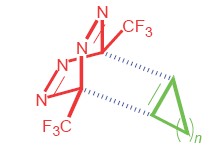

Theoretical Studies on the Mechanism of Cycloaddition Reaction between 1,2,4,5-Tetrazine and Cycloolefines
Received date: 2013-12-02
Online published: 2014-01-01
Supported by
Project supported by the National Natural Science Foundation of China (No. 21373030).
The reaction mechanism of [4+2] cycloaddition reaction between 1,2,4,5-tetrazine and cycloolefines has been investigated with several density functional theory (DFT) methods, such as CAM-B3LYP, B3LYP, X3LYP, BMK, LC-wPBE, wB97x, wB97xd, M062x and M11, and the obtained results show that all of title reactions are concerted regardless of methods used. The stability of transition state is moderated by the interaction of frontier molecular orbitals (FMO), in which cycloolefine acts as an electron-donating partner and 1,2,4,5-tetrazine acts as an electron-accepter from the charge transfer direction in the transition state. The calculated activation free-energy barrier is dependent on the size of ring in cycloolefines, i.e., the larger the size of ring in cycloolefine, the more difficult the reaction, which is related to the deformation energy when transition state is formed. The activation free energy barriers have been calculated both with gas-phase translational entropy and solution translational entropy, in which those from gas-phase translational entropy (output of Gaussian job) are far away from the experimental estimations. For those generated from solution translational entropy are comparable for most of DFT methods, in which those generated from BMK, CAM-B3LYP and X3LYP methods are more reasonable. However, rate constants calculated from both M062x and M11 methods are largely deviated from experimental observations, indicating that these two methods are not suitable for studying these types of reactions. Moreover, the wB97xd method with classical dispersion overestimates the interaction between two fragments in transition states, and thus leads to low activation free energy barrier, meaning that those transition states, stabilized by FMO interactions, are hardly to form temperate and regional dipoles for the interacting partners. The reason for the failure of these methods has been addressed in this paper.

Fang Decai , Chen Yanmei . Theoretical Studies on the Mechanism of Cycloaddition Reaction between 1,2,4,5-Tetrazine and Cycloolefines[J]. Acta Chimica Sinica, 2014 , 72(2) : 253 -256 . DOI: 10.6023/A13121206
[1] Diels, O.; Alder, K. Justus Liebig's Annalen der Chemie 1928, 460, 98.
[2] Wiberg, K. B.; Bartley, W. J. J. J. Am. Chem. Soc. 1960, 82, 6375.
[3] Lou, Y.; Horikawa, M.; Kloster, R. A.; Hawryluk, N. A.; Corey, E. J. J. Am. Chem. Soc. 2004, 126, 8916.
[4] Cadogan, J. I. G.; Cameron, D. K.; Gosney, I.; Tinley, E. J.; Wyse, S. J.; Amaro, A. J. Chem. Soc., Perkin Trans. 1 1991, 2081.
[5] Brúson, H. A.; Riener, T. W. J. Am. Chem. Soc. 1945, 67, 723.
[6] Rubin, M.; Rubina, M.; Gevorgyan, V. Synthesis 2006, 1221.
[7] Zhu, Z.-B.; Wei, Y.; Shi, M. Chem. Soc. Rev. 2011, 40, 5534.
[8] Wilson, M. R.; Taylor, R. E. Angew. Chem., Int. Ed. 2013, 52, 4078.
[9] Liu, F.; Paton, R. S.; Kim, S.; Liang, Y.; Houk, K. N. J. Am. Chem. Soc. 2013, 135, 15642.
[10] Jorgensen, W. L.; Lim, D.; Blake, J. F. J. Am. Chem. Soc. 1993, 115, 2936.
[11] Beno, B. R.; Wilsey, S.; Houk, K. N. J. Am. Chem. Soc. 1999, 121, 4816.
[12] Wilsey, S.; Houk, K. N.; Zewail, A. H. J. Am. Chem. Soc. 1999, 121, 5772.
[13] Diau, E. W.-G.; De Feyter, S.; Zewail, A. H. Chem. Phys. Lett. 1999, 304, 134.
[14] Singleton, D. A.; Schulmeier, B. E.; Hang, C.; Thomas, A. A.; Leung, S.-W.; Merrigan, S. R. Tetrahedron 2001, 57, 5149.
[15] Dinadayalane, T. C.; Vijaya, R.; Smitha, A.; Narahari Sastry, G. J. Phys. Chem. A 2002, 106, 1627.
[16] Guner, V.; Khuong, K. S.; Leach, A. G.; Lee, P. S.; Bartberger, M. D.; Houk, K. N. J. Phys. Chem. A 2003, 107, 11445.
[17] Thalhammer, F.; Wallfahrer, U.; Sauer, J. Tetrahedron Lett. 1990, 31, 6851.
[18] Hu, G. D.; Zhang, S. L.; Zhang, Q. G. Acta Chim. Sinica 2009, 67, 1019. (扈国栋, 张少龙, 张庆刚, 化学学报, 2009, 67, 1019.)
[19] Ma, G. Z.; Liu, C.; Qiu, Y. F.; Nan, J. M. Acta Chim. Sinica 2009, 67, 453. (马国正, 刘聪, 求亚芳, 南俊民, 化学学报, 2009, 67, 453.)
[20] Yi, C. H.; Zhang, Q. G. Acta Chim. Sinica 2010, 68, 2029. (伊长虹, 张庆刚, 化学学报, 2010, 68, 2029.)
[21] Gurney, R. W. Introduction to Statistical Mechanics, 1st ed., McGraw-Hill Book Company, New York, 1949.
[22] Frank, H. S. J. Chem. Phys. 1945, 13, 478.
[23] Mardirossian, N.; Head-Gordon, M. J. Chem. Theory Comput. 2013, 9, 4453.
[24] Chen, Y.-M.; Chass, G. A.; Fang, D.-C. Phys. Chem. Chem. Phys. 2014, 16, 1078.
[25] Lee, C.; Yang, W.; Parr, R. G. Phys. Rev. B 1988, 37, 785.
[26] Yanai, T.; Tew, D.; Handy, N. Chem. Phys. Lett. 2004, 393, 51.
[27] Xu, X.; Goddard, W. A. Ⅲ. Proc. Natl. Acad. Sci. U. S. A. 2004, 101, 2673.
[28] Boese, A. D.; Martin, J. M. L. J. Chem. Phys. 2004, 121, 3405.
[29] Tawada, Y.; Tsuneda, T.; Yanagisawa, S.; Yanai, T.; Hirao, K. J. Chem. Phys. 2004, 120, 8425.
[30] Chai, J.-D.; Head-Gordon, M. J. Chem. Phys. 2008, 128, 084106.
[31] Chai, J.-D.; Head-Gordon, M. Phys. Chem. Chem. Phys. 2008, 10, 6615.
[32] Zhao, Y.; Truhlar, D. G. J. Phys. Chem. 2006, 110, 5121.
[33] Peverati, R.; Truhlar, D. G. J. Phys. Chem. Lett. 2011, 2, 2810.
[34] McLean, A. D.; Chandler, G. S. J. Chem. Phys. 1980, 72, 5639.
[35] Miertus, S.; Scrocco, E.; Tomasi, J. Chem. Phys. 1981, 55, 117.
[36] Tao, J.-Y.; Mu, W.-H.; Chass, G. A.; Tang, T.-H.; Fang, D.-C. Int. J. Quantum Chem. 2013, 113, 975.
[37] Fang, D.-C. THERMO, Beijing Normal University, Beijing, China.
[38] See http://gauss.fh-bielefeld.de/aim2000.
/
| 〈 |
|
〉 |